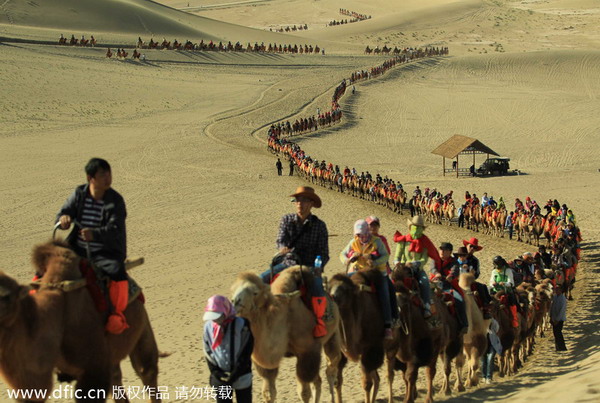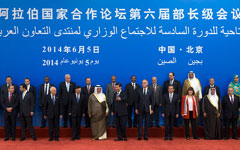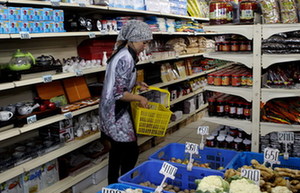|
 Tourists ride camels in the desert in the Crescent Moon Lake (Yueyaquan) and the Singing Sand Mountains scenic spot in Dunhuang city, Northwest China's Gansu province, Oct 3, 2012. [Photo / IC] |
China must reassure nations along ancient route, Russian expert says
The Silk Road Economic Belt proposed by President Xi Jinping is a platform that will be open to all countries wishing to contribute and benefit from rebuilding the ancient trade routes connecting China, Central Asia and Europe, an official from the Ministry of Commerce said on Thursday.
"The economic belt doesn't need a new mechanism. Instead, it will make full use of the existing multilateral economic cooperation agreements among different countries, but inject new content into them," said Zhong Shan, deputy international trade representative for China.
Zhong made his remarks at the opening ceremony of the two-day International Seminar on the Silk Road Economic Belt in Urumqi, capital of the Xinjiang Uygur autonomous
 |
 |
He added that the economic belt could only be built and thrive when all countries and their people can benefit from it. The idea of building an economic belt along the Silk Road, first proposed by Xi in Kazakhstan when he made a speech on China's Central Asia strategy in September, faces many difficulties.
The biggest challenge to reviving the ancient Silk Road, which dates back 2,000 years, is poor transportation infrastructure, said Li Pumin, secretary-general of the National Development and Reform Commission, the top economic planner.
Many key roads connecting China and Central Asia desperately need upgrades or reconstruction, Li said, adding that such construction work will require massive financial support from governments due to complex geographical conditions.
"Countries along the belt must jointly push forward the infrastructure construction by planning together," Li said.
Additionally, many nations are cautious about China's new proposal out of fear that China's growing presence in their countries might be a threat, so China must let them know that the economic belt is about sharing and prospering together to win their support, said Alexander Lukin, vice-president of the Diplomatic Academy of the Ministry of Foreign Affairs of Russia.
Instability caused by factors such as terrorism and separatism will also slow the progress of the construction of the economic belt, Lukin said.
"No economic development could be achieved without a stable social environment," he said.
The ancient Silk Road was abandoned for almost a century because of wars in the region. "At the same time, economic development could help to shake off poverty, which may have contributed to breed terrorism," Lukin added.
Plans are shaping up for Xinjiang to develop into the main transportation and trade hub along the economic belt.
"Three main corridors passing through southern, central and northern Xinjiang will be built as part of the plan to connect China with Central Asia, which has great marketing potential," Zhang Chunxian, Party chief of the region, said at the opening ceremony.
The region will also develop a manufacturing industry so that the products made there could be exported via the economic belt, Zhang said.
|
 |
 |
| Revival of ancient Silk Road 'essential' for Asian nations | Kazakh students say Silk Road will pave way for career openings |
